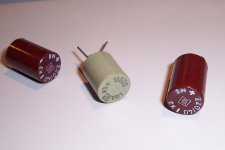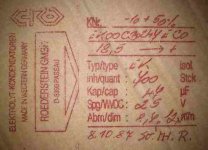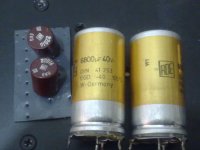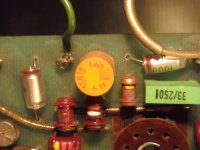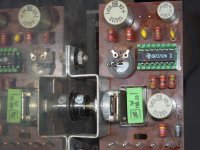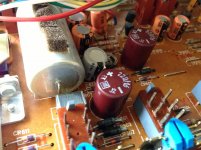Hi again Elvee
There was some speculation earlier...
...that the casing's might be something OTHER than Bakelite...
...perhaps an 'improved' sort-of Bakelite.
( I believe Phenolic, was kinda the MKII Bakelite...
...sort-of anyhow ! )
Well...
...the brown/red case, is absolutely TYPICAL of Bakelite...
...which did seem to be made in 'certain' colours...
...including ORANGE.
A friend of mine showed me some Bakelite objects ( he collects them ! ).
Orange is/was an unusual-colour he told me.
He also told me BLUE is 'quite rare' and VERY collectable...
...I'll take his word on all that !
Just looked at a brown/red Roe-cap under a microscope.
The casing is 'ever-so-slightly' chipped.
And indeed !...
...SAWDUST was mentioned earlier as well...
( my collector friend also mentioned this )
...there are what looks, remarkably like small 'wood-colour' particles, emerging from the surface of the casing.
Impossible to see with the 'naked eye' of course.
I believe also the 'porousity' of Bakelite was mentioned earlier also.
Perhaps there IS a 'controlled-venting' from an otherwise, epoxy-sealed case...
...through slightly porous Bakelite.
Perhaps THIS was one of the main ideas of using the otherwise 'fairly obsolete' material; way into I think, the 70s' & 80s'.
Bakelite also seems entirely, non-resonant ( or fairly, at least ).
All these 'high-end' capacitor manufacturer's sales-pitches; are constantly on about, anti-resonance this, anti-resonance-that.
Maybe the 'top-boffins' at Roederstein had figured this out YEARS before...
...and implemented it as standard, at a normal, sensible cost ?
Cheers.
Si.
There was some speculation earlier...
...that the casing's might be something OTHER than Bakelite...
...perhaps an 'improved' sort-of Bakelite.
( I believe Phenolic, was kinda the MKII Bakelite...
...sort-of anyhow ! )
Well...
...the brown/red case, is absolutely TYPICAL of Bakelite...
...which did seem to be made in 'certain' colours...
...including ORANGE.
A friend of mine showed me some Bakelite objects ( he collects them ! ).
Orange is/was an unusual-colour he told me.
He also told me BLUE is 'quite rare' and VERY collectable...
...I'll take his word on all that !
Just looked at a brown/red Roe-cap under a microscope.
The casing is 'ever-so-slightly' chipped.
And indeed !...
...SAWDUST was mentioned earlier as well...
( my collector friend also mentioned this )
...there are what looks, remarkably like small 'wood-colour' particles, emerging from the surface of the casing.
Impossible to see with the 'naked eye' of course.
I believe also the 'porousity' of Bakelite was mentioned earlier also.
Perhaps there IS a 'controlled-venting' from an otherwise, epoxy-sealed case...
...through slightly porous Bakelite.
Perhaps THIS was one of the main ideas of using the otherwise 'fairly obsolete' material; way into I think, the 70s' & 80s'.
Bakelite also seems entirely, non-resonant ( or fairly, at least ).
All these 'high-end' capacitor manufacturer's sales-pitches; are constantly on about, anti-resonance this, anti-resonance-that.
Maybe the 'top-boffins' at Roederstein had figured this out YEARS before...
...and implemented it as standard, at a normal, sensible cost ?
Cheers.
Si.
I don't know, I think it is a variety of Novolac, with proper additives and loads, but as I said, I am no material specialist.Hi again Elvee
There was some speculation earlier...
...that the casing's might be something OTHER than Bakelite...
...perhaps an 'improved' sort-of Bakelite.
( I believe Phenolic, was kinda the MKII Bakelite...
...sort-of anyhow ! )
Well...
...the brown/red case, is absolutely TYPICAL of Bakelite...
...which did seem to be made in 'certain' colours...
...including ORANGE.
A friend of mine showed me some Bakelite objects ( he collects them ! ).
Orange is/was an unusual-colour he told me.
He also told me BLUE is 'quite rare' and VERY collectable...
...I'll take his word on all that !
Just looked at a brown/red Roe-cap under a microscope.
The casing is 'ever-so-slightly' chipped.
And indeed !...
...SAWDUST was mentioned earlier as well...
( my collector friend also mentioned this )
...there are what looks, remarkably like small 'wood-colour' particles, emerging from the surface of the casing.
Impossible to see with the 'naked eye' of course.
I believe also the 'porousity' of Bakelite was mentioned earlier also.
Perhaps there IS a 'controlled-venting' from an otherwise, epoxy-sealed case...
...through slightly porous Bakelite.
Perhaps THIS was one of the main ideas of using the otherwise 'fairly obsolete' material; way into I think, the 70s' & 80s'.
Non-resonant (mechanically at least) is complete BS for me and it certainly was for the designers of these caps.Bakelite also seems entirely, non-resonant ( or fairly, at least ).
All these 'high-end' capacitor manufacturer's sales-pitches; are constantly on about, anti-resonance this, anti-resonance-that.
Maybe the 'top-boffins' at Roederstein had figured this out YEARS before...
...and implemented it as standard, at a normal, sensible cost ?
It is something audiophools are preoccupied about, but no serious engineer would care about it for more than half a second.
German engineers were down to earth and not superstitious at all (which is why they made such good products), and that is certainly not something they looked into.
Avoiding the movement of internal parts during vibrations and shocks is a concern, but with a radial capacitor filled with viscous liquid, that is not too much of a problem.
Electronic resonances could be more problematic, but they are well under control, and it has nothing to do with the bakelite or other case material.
I found some more in my stock, including the grey one.
I don't know if this color has a special meaning.
The esr @1KHz for this NOS 100µ/35V is 131mΩ
The 220µ/40V of more conventional aspect measure 67mΩ. They date from 1980 and have served a harsh duty: they were filter caps in a modular DC/DC converter.
I don't know if this color has a special meaning.
The esr @1KHz for this NOS 100µ/35V is 131mΩ
The 220µ/40V of more conventional aspect measure 67mΩ. They date from 1980 and have served a harsh duty: they were filter caps in a modular DC/DC converter.
Attachments
Interesting coincidence, the other day at work I pulled some boards out of an old chart recorder. I noticed some of the boards have what look like ROE rectifiers in them. Same exact bakelite case, very interesting but with ROE and ~ on the surface and four pins. Plus a bunch of Frako Caps (west germany) and loads of other stuff. I didn't know much about the rectifiers but happened to see this.
Last edited:
One way to find out what it is - touch an edge with a soldering iron. If it melts, it's not Bakelite, but something else. Bakelite is brittle, so it's a bitch to mold in thin cross-sections. The cap might use another material like PBT, a plastic commonly used to mold things like bobbins where injection vs. transfer molding is desired, but with a better resistance to heat than something like nylon.
FWIW, It looks like Brinkmann still uses some Roederstein EKR caps in his products. If quality or reliability was an issue I guess he would throw them away: brinkmann audio
Quite astonishing how user's experiences can differ.
For my part, compared to other contemporary types, I have seen very few faulty ones. As I mentioned earlier, I found some had cracked or even exploded, but it was caused by application of reverse bias.
Usually, ordinary Al caps tolerate a small percentage of reverse bias voltage during part of a cycle, but the EK do not tolerate well that kind of treatment, probably because of their hermetic construction.
There may be other factors: since they were low esr, some designers could have mistakenly thought that they were suitable for operation at high current, high temperature and high frequency. In fact, they must be 85° or perhaps 70° parts.
The equipment where I saw them were mainly professional, not consumer, conservatively designed and they weren't subjected to simultaneous stresses.
Under the same conditions, the Philips ones were awful (the ones with light blue sleeve): they simply dried up, without stress, and they even degraded under shelf storage conditions.
I cannot comment about "Japanese elco's", that is too broad.
Because the cathode connection has to be made through a thin aluminium strip welded to the bottom of the case, having a length ~150% of the cap's body.
here is my roe collection the radial electrolytics in this piccy have the same problem has the axial version..
They look like axials in (very poor) disguise. Not surprising they behave similarly.The lytics in this piccy have same problem has the axials
Hi,
my experience with those dull-red ROE capacitors is that they are very prone to failure after about 25 years.
They were heavily used by Bang & Olufsen and Revox since about 1970.
The first advice of all service technicians that I know, is to replace these capacitors, in whatever audio brand they are used.
About my quote about "Japanese" capacitors:
I have, and still am servicing Japanese audio gear, from 1960 on.
In my experience, the elco's very seldom fail.
I myself, I am daily using Japanese Sansui tuners and amplifiers from about 1968.
Only some dial lamps had to be replaced, not a single electronic component had to be replaced, all electrolytic capacitors are original.
These +40 years old units are performing very well, as new, and yes, I have compared them with current Japanese/Chinese production.
P.S.
In almost all consumer electronics, there is/was a plague of very bad electrolytic capacitors. They fail after about two years, especially in switching power supplies. I was disregarding these (Chinese) crap capacitors in this posting.
my experience with those dull-red ROE capacitors is that they are very prone to failure after about 25 years.
They were heavily used by Bang & Olufsen and Revox since about 1970.
The first advice of all service technicians that I know, is to replace these capacitors, in whatever audio brand they are used.
About my quote about "Japanese" capacitors:
I have, and still am servicing Japanese audio gear, from 1960 on.
In my experience, the elco's very seldom fail.
I myself, I am daily using Japanese Sansui tuners and amplifiers from about 1968.
Only some dial lamps had to be replaced, not a single electronic component had to be replaced, all electrolytic capacitors are original.
These +40 years old units are performing very well, as new, and yes, I have compared them with current Japanese/Chinese production.
P.S.
In almost all consumer electronics, there is/was a plague of very bad electrolytic capacitors. They fail after about two years, especially in switching power supplies. I was disregarding these (Chinese) crap capacitors in this posting.
Hi,
my experience with those dull-red ROE capacitors is that they are very prone to failure after about 25 years.
They were heavily used by Bang & Olufsen and Revox since about 1970.
The first advice of all service technicians that I know, is to replace these capacitors, in whatever audio brand they are used.
About my quote about "Japanese" capacitors:
I have, and still am servicing Japanese audio gear, from 1960 on.
In my experience, the elco's very seldom fail.
I myself, I am daily using Japanese Sansui tuners and amplifiers from about 1968.
Only some dial lamps had to be replaced, not a single electronic component had to be replaced, all electrolytic capacitors are original.
These +40 years old units are performing very well, as new, and yes, I have compared them with current Japanese/Chinese production.
P.S.
In almost all consumer electronics, there is/was a plague of very bad electrolytic capacitors. They fail after about two years, especially in switching power supplies. I was disregarding these (Chinese) crap capacitors in this posting.
It wasn't just chinese companies that got bit by this bug. Nichicon was also hit badly on several of their cap series (ones used in dell computers for example). Theirs was also exacerbated by an over filling problem that hit around the same time (too much electrolyte). The cheap chinese capacitors still fail namely because they don't use high enough purity aluminum in their caps (the copper impurities catalyze the breakdown of the electrolyte) as well as leaving out some expensive stabilizers in the electrolyte mixture.
Hi,
my experience with those dull-red ROE capacitors is that they are very prone to failure after about 25 years.
They were heavily used by Bang & Olufsen and Revox since about 1970.
The first advice of all service technicians that I know, is to replace these capacitors, in whatever audio brand they are used.
About my quote about "Japanese" capacitors:
I have, and still am servicing Japanese audio gear, from 1960 on.
In my experience, the elco's very seldom fail.
I myself, I am daily using Japanese Sansui tuners and amplifiers from about 1968.
Only some dial lamps had to be replaced, not a single electronic component had to be replaced, all electrolytic capacitors are original.
These +40 years old units are performing very well, as new, and yes, I have compared them with current Japanese/Chinese production.
P.S.
In almost all consumer electronics, there is/was a plague of very bad electrolytic capacitors. They fail after about two years, especially in switching power supplies. I was disregarding these (Chinese) crap capacitors in this posting.
Add Tandberg to the list. ROE EK used heavily by Tandberg. Would anyone know what the J2 and GPK designations stand for? My caps are ROE 220uf/16V EK J2 and ROE 470uf/16V EK GPF. I'm trying to figure out the difference between the J2 and GPK. I assume these designations tell me the tolerance/temperature range/pin spacing? I'm trying to find a data sheet for these so I can find suitable replacements. Thanks.
Attachments
Last edited:
- Status
- This old topic is closed. If you want to reopen this topic, contact a moderator using the "Report Post" button.
- Home
- Design & Build
- Parts
- Roederstein 'BAKELITE' series EK capacitors - "Living Legend" OR "Looney Legacy" ...?


